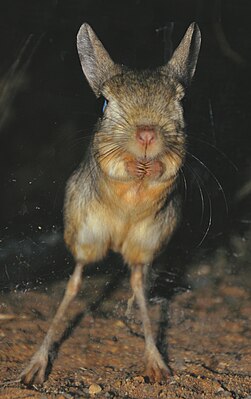Gerbils
| Gerbils | ||||||||||||
|---|---|---|---|---|---|---|---|---|---|---|---|---|

Great gerbil ( Jaculus orientalis ) |
||||||||||||
| Systematics | ||||||||||||
|
||||||||||||
| Scientific name | ||||||||||||
| Jaculus | ||||||||||||
| Erxleben , 1777 |
The gerbils ( jaculus ) are probably the best-known genus of jerboa . Despite the name, the five species are not exclusively found in deserts , but prefer arid areas in North Africa and West Asia. They can be found in diverse habitats such as scree and relatively flat sandy deserts, salt deserts, rocky valleys and pastureland.
features

The species are small to medium-sized jerboa with a head-to-trunk length of 9.5 to 16 cm. You have 3 toes on each rear foot. The toes are surrounded by a line of stiff hair. The tail is very long with up to 150% of the head body length (12.8 to 25 cm) and has a two-tone black and white end tassel. The ears are short, less than half the length of the back of the foot. The upper incisors are grooved and white. The enamel forms a Z in the first two upper molars. There are 16 teeth (1/1, 0/0, 0/0, 3/3). The top is pale to dark sand-colored or yellowish brown, the underside whitish in color.
Way of life
Like all jerboa, gerbils are nocturnal animals that stay in their burrows during the day. The widely branched system of ducts in their caves can be up to two meters deep. The bedroom is padded with camel hair or parts of plants. From the bedroom, which is also used as a nest chamber, one or two escape corridors lead directly outside. There is also a pantry in the building of Jaculus orientalis .
With their strong hind legs, gerbils can jump up to one meter high and several meters far. In search of food, they cover distances of up to 14 km. The diet consists of roots, seeds and other parts of plants. The entire water requirement is obtained from food.
In most parts of their range, gerbils do not hibernate and are still active on the coldest nights. However, some zoologists claim to have observed hibernation in certain regions, for example Iraq and Morocco . On the other hand, there is certain to be a kind of torpor (paralysis) that gerbils fall into when there is a shortage of food and when the weather is cold and rainy. By lowering all body functions, you can save energy and thus better survive times that are unfavorable for you. Jaculus jaculus lives solitary , the other species live in small groups.
In captivity, gerbils can have offspring up to four times a year. A litter consists of three to four (exceptionally 2 to 10) cubs who are born after a gestation period of 25 to 40 days. Life expectancy in human care is over six years.
Systematics
The following five species are commonly assigned to this genus:
- Small gerbil , Jaculus jaculus , Morocco and Senegal to southwest Iran and Somalia
- Blanford Jerboa , Jaculus blanfordi , Iran, Afghanistan , Southwest Pakistan
- Jaculus hirtipes
- Jaculus loftusi
- Great gerbil , Jaculus orientalis , Morocco to southern Israel
Occasionally the Lichtenstein jerboa is included in this genus, but it is usually placed in its own genus Eremodipus .
Humans and gerbils
Occasionally, gerbils are kept by private individuals. The animals kept are usually Jaculus jaculus or Jaculus orientalis. While the offspring of the small gerbil is regularly successful, it is rather rare in the latter species.
The great jerboa is considered a grain pest in parts of North Africa . It is therefore fought in many areas. In addition, the jerboas are eaten by some Bedouin tribes . Despite hunting, none of the four species is considered endangered, even if the population of Jaculus blanfordi is declining.
Web links
Individual evidence
- ↑ a b c d e f g h i j k l Ronald M. Nowak: Walker's Mammals of the World. Volume 2. 6th edition. Johns Hopkins University Press, Baltimore MD et al. 1999, ISBN 0-8018-5789-9 , p. 1339.
- ↑ Stéphane Aulagnier, Patrick Haffner, Anthony J. Mitchell-Jones, François Moutou, Jan Zima: The mammals of Europe, North Africa and the Middle East. The destination guide. Haupt, Bern et al. 2009, ISBN 978-3-258-07506-8 , p. 182.
- ↑ Don E. Wilson, Thomas E. Lacher Jr., Russell A. Mittermeier (eds.): Handbook of the Mammals of the World. Volume 7 - Rodents II. Lynx Edicions, 2017, ISBN 978-84-16728-04-6 , p. 97.
- ↑ Shenbrot, G. & Molur, S. 2008. Jaculus blanfordi . In: IUCN 2010. IUCN Red List of Threatened Species. Version 2010.1. <www.iucnredlist.org>. (accessed December 25, 2009)